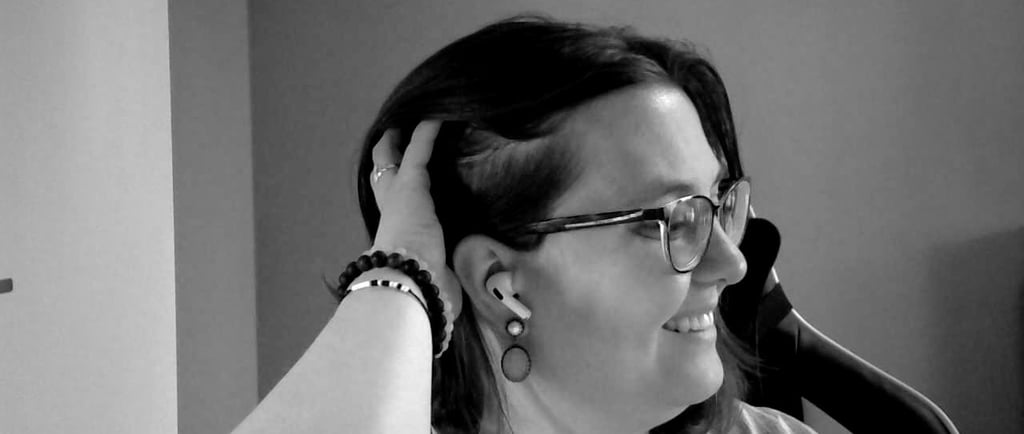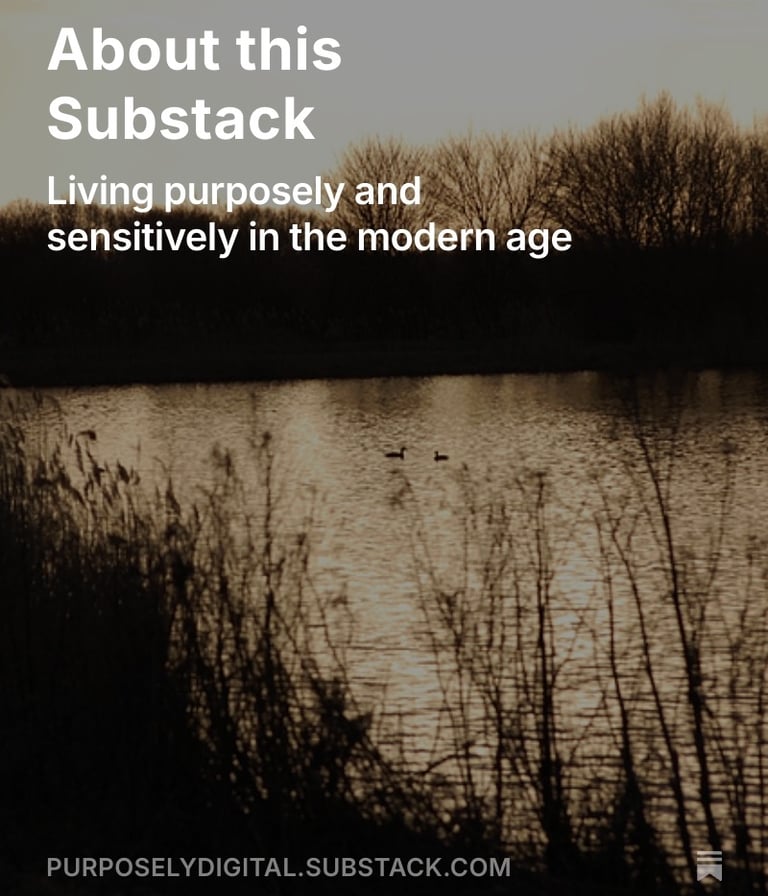50% OFF FALL PROMOTION! Step into fall purposely with 1:1 coaching. Only 2 coaching slots available. Click HERE.
Listening to Music at the Grocery Store
How sensitive humans can use technology to create an environment of thriving
Sarah E. Carter, PhD
7/31/20256 min read


I remember entering my first grocery store after moving to The Netherlands.
The lights. The noise. The tight aisles. So much shoved in a small space.
And all this after the sights, sounds, and smells of biking there, something I was still getting used to doing in a country where bikes outnumber people by a factor of 1.3.
While I had of course done grocery shopping before, in the US where I grew up, the aisles were bigger, personal space was more, and we drove rather than biked. While I have heard some people complain about the overwhelming choice and variety of products (and the “paradox of choice” is a real phenomenon), I was much more accustomed to it. I was able to keep my space, and all of us USA shoppers wielded our grocery carts as some sort of divider that defined our personal bubbles.
***
8.5 years on here, things are better. We all, of course, adjust to our environments with time. But still - the grocery store is not a place I enjoy; more a necessary place that often leaves me drained after I go.
Today, I walked up to our nearby Jumbo (a Dutch grocery chain) and the fluorescent yellow lights, families shopping, and heat just felt like… too much.
So I plopped in my nose-canceling earbuds, and BOOM - a different world emerged.
I could more calmly focus on my list and allow myself to flow with the music.
Even the sights around me softened, from threatening sensory overload to things of beauty. As George Gershwin’s “Rhapsody in Blue” played, the world spun around me as if in rhythm, and it was a beautiful dance. It was a potent reminder of something I wrote about previously - that the world is, indeed, music.
Calming, in an artistic order and dance, that I joined in to. Dodging kids. Politely waiting to return my statiegeld bottles. And I was smiling, calm. As I exited the store, I watched children sprint after their parents in the sun, a worker rest on their lunch break smoking a cigarette, a student driver tentatively driving by, and people biking in that classic Dutch rush of bakfiets and a sea of tall legs. The andantino moderato section of Gershwin’s masterwork swells and sings on.
While things were not perfect, things seemed .. right. And I was part of it, moving on into the next section of some large musical masterwork.
***
As a coach and in my personal life, I often hear people talk about the ways technology has made things overstimulating. Doomscrolling on social media, smartphones pinging, never a moment of peace. But there are beautiful ways that technology can enhance our experience as sensitive humans, too.
In my case - thank god for noise canceling headphones and earbuds! For planes, trains, buses and.. that accursed grocery store! They seem to help me make sense of the world around me, harmonizing the movement, lights, into some great masterwork that just makes sense. I feel deeply and am connected. And so I can thrive - in this case, in as simple a way as getting my groceries done and heading home happy instead of overstimulated and drained.
***
This all relates to something sensitivity researchers call the sensitive boost effect. In brief, in supportive environments, those with higher levels of sensitivity thrive and exceed more than those with standard levels of sensitivity. However, if a sensitive human is in a an environment that runs against their sensitivity - they tend to fall further, and hit harder.
If we create environments that suite our sensitivity, we thrive. Music has known and profound effects on shaping our moods and memories, and we can use our earbuds to create a sound environment that is best suited to our needs and boost ourselves into better moods.
However, we can also do the opposite. Interestingly, music and sound we do not like or are not best suited to our moods can have the opposite effect. How many times have I had my phone on shuffle just to start to feel tense, realizing that my entire being was “resisting” this song because it did not harmonize with me at that moment? Or I am listening to the garble of pop music, screaming children, chatter, and the cashier running things up in the grocery store? Sure, in both instances, I can “push through” - but my energy is quite decreased and my mood is down. The boost shoots… downward.
So, how can we, as sensitive humans, harness the power of the sensitive boost effect and use technology in a manner that helps us thrive?
There’s lots to say on this - perhaps more for other blog post - however, the central component I’ve found on my own sensitive journey is honestly listening to your body to tell you what serves you.
Listening to your body - sounds easy, right?
Not so! Finding your own blend of beneficial tech to create your own sensitive thriving environment is challenging. Not only is it immensely personal, it’s hard to do in an age that is constantly vying for our attention with clickbait headlines, social media algorithms that addict us, and phones pinging away, promising a new dopamine hit.
However, as a sensitive human, you are especially well poised to use your sensitive superpowers to find what works for you.
Many sensitive humans, like me, have incredible attuned intuitions and bodies emeshed with emotion. If I am mindful, present, I can FEEL what is serving me. Is scrolling social media reels tonight serving me? My shoulders are tense. It think it is making me anxious. What would be better for me right now?
And we can learn how to harness that sensitive boost effect and create thriving environments by learning from these moment to moment experiences. What music makes me feel calmer on a busy train, and can I create a playlist? These headphones give me a headache, but these seem to work for me. I don’t feel comfortable using AI to write any text, but I am OK asking for advice from time to time (real life example: I found an injured mole in the woods. What can I do?). And only Claude, whose ethical standards fit better with my values than ChatGPT.
Understanding what makes us thrive can also help us define clear boundaries, safeguarding us from what does not serve us. For me, this means all the notifications on my phone are disabled, and I check email and messages a few times a day. Friends and family know to call me in case of an emergency. I do not have any social media apps on my phone because they tend to catch my attention and take me to places that do not serve me - states of anxiety, fear, and depression. I schedule times to check these apps and try to stick to it.
***
Thriving in the 21st centuary as a sensitive human is likely not about doing away with technology completely - whether it be smartphones, social media, or AI. For some, it may be what their bodies are telling them - to completely step away. But for most, I suspect their ideal environment for harnessing the sensitive boost effect will be somewhere in the middle.
It’s hard to find your middle - but not impossible. As a sensitive human, you have gifts that can help you get there. You CAN find your own recipe for thriving and harness that sensitive boost effect. And, while I have shared some of what I do here in the spirit of hope (it IS possible), your own balance will almost undoubtedly look different than mine.
But I believe that you can find it.
Take that first step, sink deep into your wonderful intuition and bodily wisdom. Let it guide you on your way.
You got this, sensitive human.
If you’d like to start harnessing the sensitive boost effect together, I’d love to speak with you. You can book a complimentary clarity call here, where we will start defining what balance of technology helps you thrive - sensitively.
The wonderful, glorious masterwork, Rhapsody in Blue, inspired by bustling life in New York City:
https://www.youtube.com/watch?v=cH2PH0auTUU&list=RDcH2PH0auTUU&start_radio=1


Enjoying Purposely, Sensitively, Digitally ?
Get notified when a new blog is posted (and access to other writings!) by subscribing on Substack!
Always and forever free. Offered with love. No payment required.


Did this post speak to you?
Let's chat! I'd love to hear from you.
Purposely Digital
Empowering Sensitive Humans
hello[at]purposely-digital.com
© 2025. Purposely Digital. All rights reserved.
Proudly AI Free
All writing done by humans, for humans
A Privacy-By-Design Business
Because it's your data - your choice
KvK #: 97684155
VAT ID: NL005284412B47
Business Address
De Nieuwe Erven 3
13359
5431 NV Cuijk
Nederland


